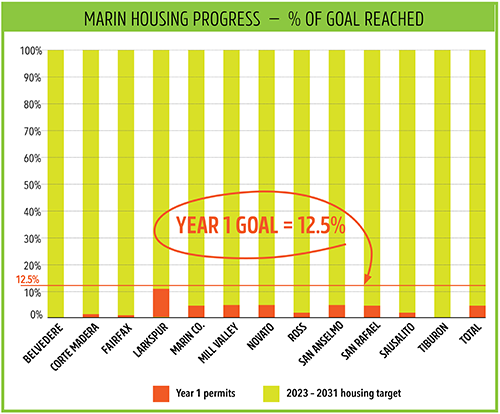Tenant Protection Measures in Marin
Marin’s housing shortage continues to inflict severe hardships on families and local workers struggling to maintain their access to schools, jobs, and other important resources. Behind statistics describing the long-standing housing crisis for Bay Area renters are their stories about painful damage inflicted by our regional shortage of affordable housing:
- A single mom needs affordable options to remain in San Rafael close to her children’s elementary school and the office where she works.
- A senior desperately searches for a new rental opportunity after the owner decides to sell.
- A renter with disabilities pushed out by rent increases can’t find options near her medical services.

Despite some signs the rental market has temporarily cooled slightly in the Bay Area, local renters continue to face daunting challenges to their housing security. According to a new 2024 report “Out of Reach: The High Cost of Housing,” Marin County represents the country’s second most expensive jurisdiction (Eight of the 10 most expensive U.S. housing markets are in California.). This study found that the average rent for a two-bedroom apartment in Marin County requires an hourly wage of $66.40 – far above the wage most renters can secure with local jobs. For context, the Marin minimum wage is $18 per hour — even full time employment would not suffice to cover minimal rent. The discrepancy between housing costs and incomes results in insurmountable obstacles for Marin renters.
The income/housing gap poses extreme hardships for families, people with disabilities, and local workers struggling to maintain housing security in Marin. Demonstrably inadequate housing accessibility for all segments of Marin’s population can – and does – produce disastrous effects. Even market-rate housing is a huge financial stretch except for those fortunate folks at the top end of the economic ladder. Marin’s history of opposing new housing has resulted in people having to double-up in overcrowded rental units, and has led to more severe segregation, ever-increasing traffic congestion, and the signs of homelessness that we see in our neighborhoods.
When faced with loss of their housing, too many renters have only few options:
- Leave the community and begin commuting in and out of Marin daily, contributing to our traffic problem, or worse, leave Marin’s workforce altogether
- Move in with another household, increasing the levels of overcrowding in the county
- Fall into homelessness
In order to combat the devastating effects of pricing-out, overcrowding, and homelessness, Marin must act on two fronts: fund and construct more affordable housing, and protect those most at risk of losing their housing security.
Here are two examples of practices that could be remedied, at least in part, with good public policy:
- Marin’s last pockets of affordable housing for local workers and retired people can still be found in our limited number of mobile home parks, but these remain under intense financial pressure from owners and investors eager to transform them into richer sources of cash.
- Investment companies have been seeking opportunities in properties held for many years by the same owner who hasn’t relentlessly increased rents over time; when properties are sold, however, long-time renters face severe pressure when new owners sharply increase rental rates.
Although the state has increased numerical allocations for more affordable housing in local jurisdictions, this has not yet resulted in significant improvements. For example, Marin County’s Annual Housing Element Progress Report shows the county planned only 16 units for people with extremely low incomes in 2023, but with an eight-year allocation of 550 units the county fell far short with less than one-quarter the production rate required to meet the needs of these renters. MEHC summarizes Progress Report results here>>
The below chart of the housing plans for all 12 Marin jurisdictions during the current eight-year housing element planning cycle shows that unincorporated Marin County and all the other cities and towns aside from Larkspur are falling woefully short of their current planning goals, with the average performance far below the state’s required benchmark after the first year of our current cycle. For housing to meet the 8-year cycle targets, each jurisdiction must produce 12.5% of its goal every year to be on track. Clearly, Marin is barely off the starting line at this point.

MEASURE
Fairfax Measure I: This measure was put forward by landlords arguing against the rent control already in place in Fairfax. Measure I would repeal current Fairfax tenant protections, as well as some protections that Fairfax renters have had for years. It would leave Fairfax renters worse off than when tenant protections were initially raised to the Town Council. The existing rent control regulation is aligned with state law; this measure would repeal it, and replace it with fewer protections for tenants.
MEHC SAYS
NO on Measure I
Larkspur Measure K: Would keep rent affordable, prevents unfair evictions, provides a fair return on rents, helps combat displacement from Marin
YES on Measure K
San Anselmo Measure O: Would provide Just Cause tenant protections
YES on Measure O
San Anselmo Measure N: Would implement rent stabilization
YES on Measure N
State Proposition
MEHC SAYS
STATE PROPOSITION 33: Prohibit State Limitation on Local Rent Control Initiative
MEHC has some concerns about this measure, we continue to research it. At this point, we have not taken a position on it, but will likely do so before the election. The League of Women Voters of Marin County will conduct its Pros and Cons event on all the state Propositions on October 7th. We encourage anyone interested in this proposition and other state ballot propositions to attend.
MEHC is a working member of the Housing For All Marin coalition to educate Marinites on affordable housing and the need for more funding. The coalition is focusing efforts on Proposition 5. The passage of Prop 5 is necessary to pave the way for affordable housing bond measures in the future.
We invite you to attend the Housing For All Marin Community Forum on Tuesday Sept. 10, 2 – 4 pm at North Marin Community Services (680 Wilson Ave, Novato) to learn more and get involved. Register here >>
| UPCOMING EVENTS – MARK YOUR CALENDAR |
| All events are open to the community. |
| Let’s Talk About Housing: Housing in Marin and What’s on the Ballot in November Monday, September 9, 11:30am. The Marin League of Women Voters will host MEHC’s Let’s Talk about Housing presentation. 4340 Redwood Hwy, Suite F-133, San Rafael. More info here >> Housing and Voting — hosted by Hope for Housing Thursday, September 26, 6 – 8pm Housing will be on the November 2024 ballot. Speakers include Chris Lodgson, Coalition for a Justice Equitable California and Jenny Silva, MEHC. Marin City Senior Center, 640 Drake Ave, Sausalito PROs and CONs – Prop 33: Marin League of Women Voters Tuesday, October 1, 12:30 – 1:30 League of Women Voters will hold a public session on Prop 33. In English with Spanish simultaneous interpretation channel. Hosted by North Marin Community Services. MEHC’s ANNUAL FRIENDRAISER! Thursday, October 10, 5 pm Join MEHC for a night of fun, food, drinks, and conversations about affordable housing in Marin! Special guest Paul Fordham, Co-CEO Homeward Bound, will speak. Held at Homeward Bound in Novato. Optional tour at 4:30 pm. GET YOUR FREE TICKETS NOW! |
 You can be a part of MEHC’s important work by reading and sharing our monthly PERSPECTIVE newsletters, joining our weekly COMING UP IN HOUSING email (signup forms here>>), participating in our advocacy campaigns, and also, if you can, by making a donation to help defray our expenses. Thank you. |
